
Document Operation (26)
Split a Word document into multiple documents by section break in C#
2016-07-25 08:45:33 Written by support iceblueIn Word, we can split a word document in an easiest way - open a copy of the original document, delete the sections that we don’t want and then save the remains to local drive. But doing this section by section is rather cumbersome and boring. This article will explain how we can use Spire.Doc for .NET to programmatically split a Word document into multiple documents by section break instead of copying and deleting manually.
Detail steps and code snippets:
Step 1: Initialize a new word document object and load the original word document which has two sections.
Document document = new Document();
document.LoadFromFile("Test.docx");
Step 2: Define another new word document object.
Document newWord;
Step 3: Traverse through all sections of the original word document, clone each section and add it to a new word document as new section, then save the document to specific path.
for (int i = 0; i < document.Sections.Count; i++)
{
newWord = new Document();
newWord.Sections.Add(document.Sections[i].Clone());
newWord.SaveToFile(String.Format(@"test\out_{0}.docx", i));
}
Run the project and we'll get the following output:
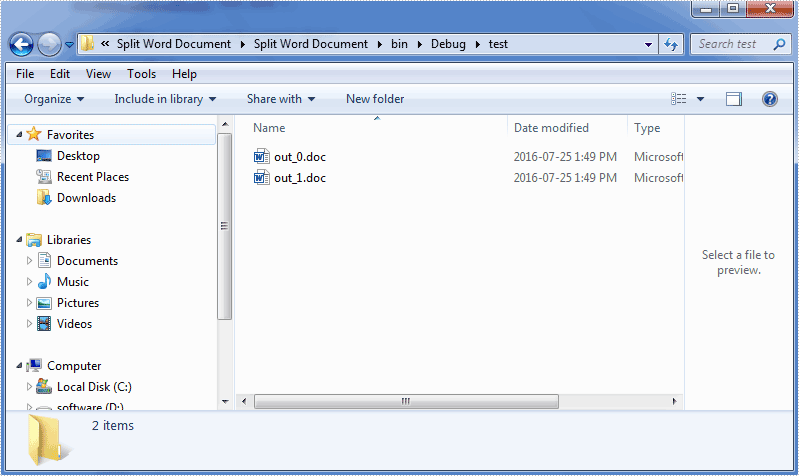
Full codes:
using System;
using Spire.Doc;
namespace Split_Word_Document
{
class Program
{
static void Main(string[] args)
{
Document document = new Document();
document.LoadFromFile("Test.doc");
Document newWord;
for (int i = 0; i < document.Sections.Count; i++)
{
newWord = new Document();
newWord.Sections.Add(document.Sections[i].Clone());
newWord.SaveToFile(String.Format(@"test\out_{0}.docx", i));
}
}
}
}
Transferring content between Microsoft Word documents is a frequent need for many users. Whether you're consolidating information from multiple sources or reorganizing the structure of a document, being able to effectively copy and paste text, graphics, and formatting is crucial.
This article demonstrates how to copy content from one Word document to another using C# and Spire.Doc for .NET.
- Copy Specified Paragraphs from One Word Document to Another
- Copy a Section from One Word Document to Another
- Copy the Entire Document and Append it to Another
- Create a Copy of a Word Document
Install Spire.Doc for .NET
To begin with, you need to add the DLL files included in the Spire.Doc for.NET package as references in your .NET project. The DLL files can be either downloaded from this link or installed via NuGet.
PM> Install-Package Spire.Doc
Copy Specified Paragraphs from One Word Document to Another in C#
With Spire.Doc library for .NET, you can clone individual paragraphs using the Paragraph.Clone() method, and then add the cloned paragraphs to a different Word document using the ParagraphCollection.Add() method. This allows you to selectively copy and transfer content between documents.
To copy specified paragraphs from one Word document to another, follow these steps:
- Create a Document object to load the source file.
- Create another Document object to load the target file.
- Get the specified paragraphs from the source file.
- Clone these paragraphs using Paragraph.Clone() method.
- Add the cloned paragraphs to the target file using ParagraphCollection.Add() method.
- Save the target file to a different Word file.
- C#
using Spire.Doc;
using Spire.Doc.Documents;
namespace CopyParagraphs
{
class Program
{
static void Main(string[] args)
{
// Create a Document object
Document sourceDoc = new Document();
// Load the source file
sourceDoc.LoadFromFile("C:\\Users\\Administrator\\Desktop\\source.docx");
// Get the specified paragraphs from the source file
Paragraph p1 = sourceDoc.Sections[0].Paragraphs[8];
Paragraph p2 = sourceDoc.Sections[0].Paragraphs[9];
// Create another Document object
Document targetDoc = new Document();
// Load the target file
targetDoc.LoadFromFile("C:\\Users\\Administrator\\Desktop\\target.docx");
// Get the last section
Section lastSection = targetDoc.LastSection;
// Add the paragraphs from the soure file to the target file
lastSection.Paragraphs.Add((Paragraph)p1.Clone());
lastSection.Paragraphs.Add((Paragraph)p2.Clone());
// Save the target file to a different Word file
targetDoc.SaveToFile("CopyParagraphs.docx", FileFormat.Docx2019);
// Dispose resources
sourceDoc.Dispose();
targetDoc.Dispose();
}
}
}
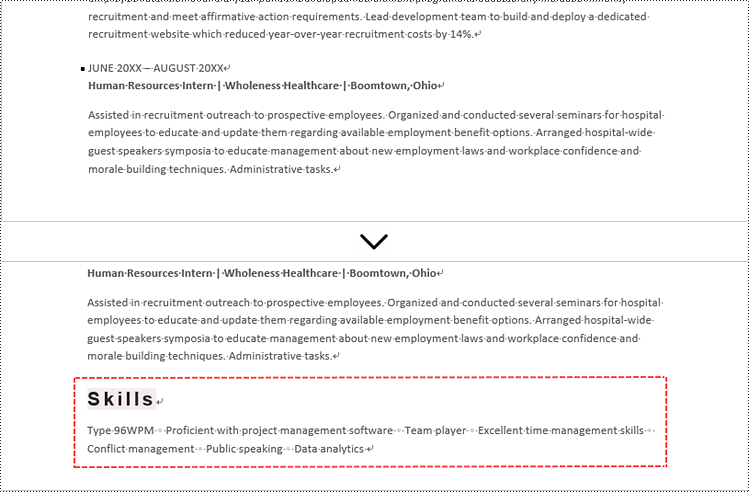
Copy a Section from One Word Document to Another in C#
A section in a Word document can contain not only paragraphs, but also other elements such as tables. To copy an entire section from one Word document to another, you need to iterate through all the child objects within the section and add them individually to a specified section in the target document.
The steps to copy a section between different Word documents are:
- Create Document objects to load the source file and the target file, respectively.
- Get the specified section from the source file.
- Iterate through the child objects in the section, and clone these objects using DocumentObject.Clone() method.
- Add the cloned child objects to a specified section of the target file using DocumentObjectCollection.Add() method.
- Save the updated target file to a new file.
- C#
using Spire.Doc;
namespace CopySection
{
class Program
{
static void Main(string[] args)
{
// Create a Document object
Document sourceDoc = new Document();
// Load the source file
sourceDoc.LoadFromFile("C:\\Users\\Administrator\\Desktop\\source.docx");
// Get the specified section from the source file
Section section = sourceDoc.Sections[0];
// Create another Document object
Document targetDoc = new Document();
// Load the target file
targetDoc.LoadFromFile("C:\\Users\\Administrator\\Desktop\\target.docx");
// Get the last section of the target file
Section lastSection = targetDoc.LastSection;
// Iterate through the child objects in the selected section
foreach (DocumentObject obj in section.Body.ChildObjects)
{
// Add the child object to the last section of the target file
lastSection.Body.ChildObjects.Add(obj.Clone());
}
// Save the target file to a different Word file
targetDoc.SaveToFile("CopySection.docx", FileFormat.Docx2019);
// Dispose resources
sourceDoc.Dispose();
targetDoc.Dispose();
}
}
}
Copy the Entire Document and Append it to Another in C#
To copy the full contents from one Word document into another, you can use the Document.InsertTextFromFile() method. This method appends the source document's contents to the target document, starting on a new page.
The steps to copy the entire document and append it to another are as follows:
- Create a Document object.
- Load a Word file (target file) from the given file path.
- Insert content of a different Word document to the target file using Document.InsertTextFromFile() method.
- Save the updated target file to a new Word document.
- C#
using Spire.Doc;
namespace CopyEntireDocument
{
class Program
{
static void Main(string[] args)
{
// Specify the path of the source document
String sourceFile = "C:\\Users\\Administrator\\Desktop\\source.docx";
// Create a Document object
Document targetDoc = new Document();
// Load the target file
targetDoc.LoadFromFile("C:\\Users\\Administrator\\Desktop\\target.docx");
// Insert content of the source file to the target file
targetDoc.InsertTextFromFile(sourceFile, FileFormat.Docx);
// Save the target file to a different Word file
targetDoc.SaveToFile("CopyEntireDocuemnt.docx", FileFormat.Docx2019);
// Dispose resources
targetDoc.Dispose();
}
}
}
Create a Copy of a Word Document in C#
Using Spire.Doc library for .NET, you can leverage the Document.Clone() method to easily duplicate a Word document.
Here are the steps to create a copy of a Word document:
- Create a Document object.
- Load a Word file from the given file path.
- Clone the file using Document.Clone() method.
- Save the cloned document to a new Word file.
- C#
using Spire.Doc;
namespace CloneWordDocument
{
class Program
{
static void Main(string[] args)
{
// Create a new document object
Document sourceDoc = new Document();
// Load a Word file
sourceDoc.LoadFromFile("C:\\Users\\Administrator\\Desktop\\sample.docx");
// Clone the document
Document newDoc = sourceDoc.Clone();
// Save the cloned document as a docx file
newDoc.SaveToFile("Copy.docx", FileFormat.Docx);
// Dispose resources
sourceDoc.Dispose();
newDoc.Dispose();
}
}
}
Apply for a Temporary License
If you'd like to remove the evaluation message from the generated documents, or to get rid of the function limitations, please request a 30-day trial license for yourself.
How to Download a Word Document from URL in C#, VB.NET
2015-09-09 07:39:18 Written by support iceblueNowadays, we're facing a bigger chance to download a file from URL since more documents are electronically delivered by internet. In this article, I'll introduce how to download a Word document from URL programmatically using Spire.Doc in C#, VB.NET.
Spire.Doc does not provide a method to download a Word file directly from URL. However, you can download the file from URL into a MemoryStream and then use Spire.Doc to load the document from MemoryStream and save as a new Word document to local folder.
Code Snippet:
Step 1: Initialize a new Word document.
Document doc = new Document();
Step 2: Initialize a new instance of WebClient class.
WebClient webClient = new WebClient();
Step 3: Call WebClient.DownloadData(string address) method to load the data from URL. Save the data to a MemoryStream, then call Document.LoadFromStream() method to load the Word document from MemoryStream.
using (MemoryStream ms = new MemoryStream(webClient.DownloadData("http://www.e-iceblue.com/images/test.docx")))
{
doc.LoadFromStream(ms,FileFormat.Docx);
}
Step 4: Save the file.
doc.SaveToFile("result.docx",FileFormat.Docx);
Run the program, the targeted file will be downloaded and saved as a new Word file in Bin folder.
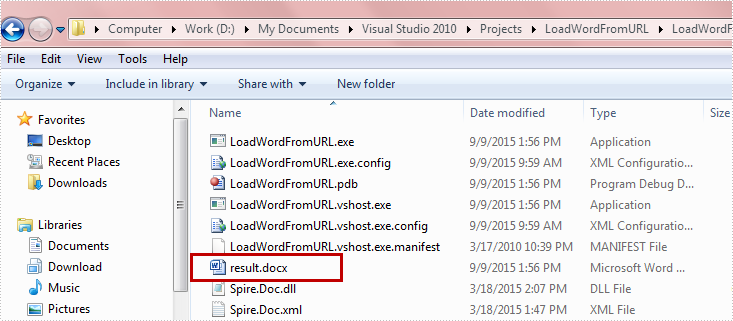
Full Code:
using Spire.Doc;
using System.IO;
using System.Net;
namespace DownloadfromURL
{
class Program
{
static void Main(string[] args)
{
Document doc = new Document();
WebClient webClient = new WebClient();
using (MemoryStream ms = new MemoryStream(webClient.DownloadData("http://www.e-iceblue.com/images/test.docx")))
{
doc.LoadFromStream(ms, FileFormat.Docx);
}
doc.SaveToFile("result.docx", FileFormat.Docx);
}
}
}
Imports Spire.Doc
Imports System.IO
Imports System.Net
Namespace DownloadfromURL
Class Program
Private Shared Sub Main(args As String())
Dim doc As New Document()
Dim webClient As New WebClient()
Using ms As New MemoryStream(webClient.DownloadData("http://www.e-iceblue.com/images/test.docx"))
doc.LoadFromStream(ms, FileFormat.Docx)
End Using
doc.SaveToFile("result.docx", FileFormat.Docx)
End Sub
End Class
End Namespace
Sometimes in word files, we type another language rather than default, and need spellers and other proofing tools adjust to the language we typed.
This article is talking about how to alter language dictionary as non-default language via Spire.Doc. Here take English as default language and alter to Spanish in Peru as an example.
As for more language information, refer this Link to Microsoft Locale ID Values.
Here are the steps:
Step 1: Create a new word document.
Document document = new Document();
Step 2: Add new section and paragraph to the document.
Section sec = document.AddSection(); Paragraph para = sec.AddParagraph();
Step 3: Add a textRange for the paragraph and append some Peru Spanish words.
TextRange txtRange = para.AppendText("corrige según diccionario en inglés");
txtRange.CharacterFormat.LocaleIdASCII = 10250;
Step 4: Save and review.
document.SaveToFile("result.docx", FileFormat.Docx2013);
System.Diagnostics.Process.Start("result.docx");
Here is the result screenshot.
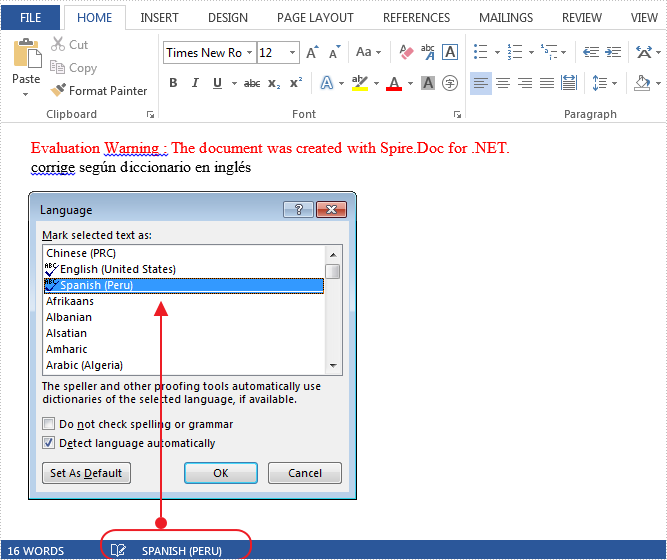
Full Code:
using Spire.Doc.Documents;
using Spire.Doc.Fields;
namespace AlterLang
{
class Program
{
static void Main(string[] args)
{
Document document = new Document();
Section sec = document.AddSection();
Paragraph para = sec.AddParagraph();
TextRange txtRange = para.AppendText("corrige según diccionario en inglés");
txtRange.CharacterFormat.LocaleIdASCII = 10250;
document.SaveToFile("result.docx", FileFormat.Docx2013);
System.Diagnostics.Process.Start("result.docx");
}
}
}
Count the number of words in a document in C#, VB.NET
2014-10-13 07:20:07 Written by support iceblueWhen you type in a document, Word automatically counts the number of pages and words in your document and displays them on the status bar – Word Count, at the bottom of the workspace. But how can we get the number of words, characters in an existing Word document through programming? This article aims to give you a simple solution offered by Spire.Doc.
Test file:
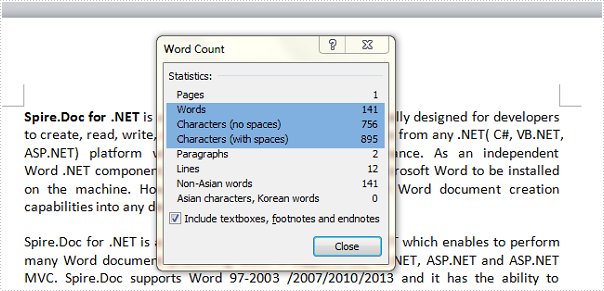
Detailed Steps for Getting the Number of Words and Characters
Step 1: Create a new instance of Spire.Doc.Document class and load the test file.
Document doc = new Document();
doc.LoadFromFile("test.docx", FileFormat.Docx2010);
Step 2: Display the number of words, characters including or excluding spaces on console.
Console.WriteLine("CharCount: " + doc.BuiltinDocumentProperties.CharCount);
Console.WriteLine("CharCountWithSpace: " + doc.BuiltinDocumentProperties.CharCountWithSpace);
Console.WriteLine("WordCount: " + doc.BuiltinDocumentProperties.WordCount);
Output:
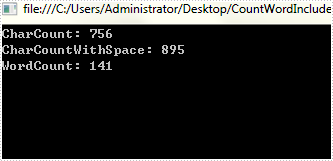
Full Code:
using Spire.Doc;
using System;
namespace CountNumber
{
class Program
{
static void Main(string[] args)
{
Document doc = new Document();
doc.LoadFromFile("test.docx", FileFormat.Docx2010);
Console.WriteLine("CharCount: " + doc.BuiltinDocumentProperties.CharCount);
Console.WriteLine("CharCountWithSpace: " + doc.BuiltinDocumentProperties.CharCountWithSpace);
Console.WriteLine("WordCount: " + doc.BuiltinDocumentProperties.WordCount);
Console.ReadKey();
}
}
}
Imports Spire.Doc
Namespace CountNumber
Class Program
Private Shared Sub Main(args As String())
Dim doc As New Document()
doc.LoadFromFile("test.docx", FileFormat.Docx2010)
Console.WriteLine("CharCount: " + doc.BuiltinDocumentProperties.CharCount)
Console.WriteLine("CharCountWithSpace: " + doc.BuiltinDocumentProperties.CharCountWithSpace)
Console.WriteLine("WordCount: " + doc.BuiltinDocumentProperties.WordCount)
Console.ReadKey()
End Sub
End Class
End Namespace
When dealing with Word documents, sometimes developers need to merge multiple files into a single file. Spire.Doc, especially designed for developers enables you to manipulate doc files easily and flexibly.
There is already a document introducing how to merge doc files. Check it here:
.NET Merge Word - Merge Multiple Word Documents into One in C# and VB.NET
Using the method above, you have to copy sections one by one. But the new method just concatenates them. It has improved and is very easy to use
Step 1: Load the original word file "A Good Man.docx".
document.LoadFromFile("A Good Man.docx", FileFormat.Docx);
Step 2: Merge another word file "Original Word.docx" to the original one.
document.InsertTextFromFile("Original Word.docx", FileFormat.Docx);
Step 3: Save the file.
document.SaveToFile("MergedFile.docx", FileFormat.Docx);
Full code and screenshot:
static void Main(string[] args)
{
Document document = new Document();
document.LoadFromFile("A Good Man.docx", FileFormat.Docx);
document.InsertTextFromFile("Original Word.docx", FileFormat.Docx);
document.SaveToFile("MergedFile.docx", FileFormat.Docx);
System.Diagnostics.Process.Start("MergedFile.docx");
}
Full code and screenshot:
using Spire.Doc;
namespace MergeWord
{
class Program
{
static void Main(string[] args)
{
Document document = new Document();
document.LoadFromFile("A Good Man.docx", FileFormat.Docx);
document.InsertTextFromFile("Original Word.docx", FileFormat.Docx);
document.SaveToFile("MergedFile.docx", FileFormat.Docx);
System.Diagnostics.Process.Start("MergedFile.docx");
}
}
}
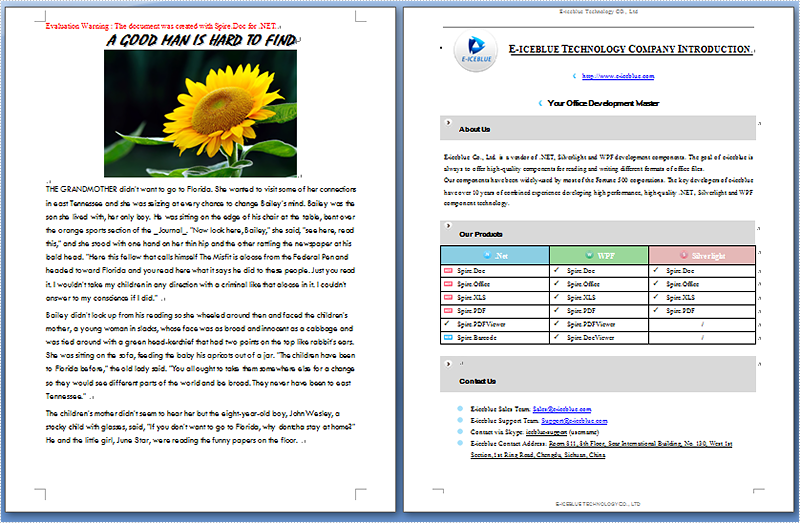
Document properties (also known as metadata) are a set of information about a document. All Word documents come with a set of built-in document properties, including title, author name, subject, keywords, etc. In addition to the built-in document properties, Microsoft Word also allows users to add custom document properties to Word documents. In this article, we will explain how to add these document properties to Word documents in C# and VB.NET using Spire.Doc for .NET.
- Add Built-in Document Properties to a Word Document
- Add Custom Document Properties to a Word Document
Install Spire.Doc for .NET
To begin with, you need to add the DLL files included in the Spire.Doc for.NET package as references in your .NET project. The DLL files can be either downloaded from this link or installed via NuGet.
PM> Install-Package Spire.Doc
Add Built-in Document Properties to a Word Document in C# and VB.NET
A built-in document property consists of a name and a value. You cannot set or change the name of a built-in document property as it's predefined by Microsoft Word, but you can set or change its value. The following steps demonstrate how to set values for built-in document properties in a Word document:
- Initialize an instance of Document class.
- Load a Word document using Document.LoadFromFile() method.
- Get the built-in document properties of the document through Document.BuiltinDocumentProperties property.
- Set values for specific document properties such as title, subject and author through Title, Subject and Author properties of BuiltinDocumentProperties class.
- Save the result document using Document.SaveToFile() method.
- C#
- VB.NET
using Spire.Doc;
namespace BuiltinDocumentProperties
{
class Program
{
static void Main(string[] args)
{
//Create a Document instance
Document document = new Document();
//Load a Word document
document.LoadFromFile("Sample.docx");
//Add built-in document properties to the document
BuiltinDocumentProperties standardProperties = document.BuiltinDocumentProperties;
standardProperties.Title = "Add Document Properties";
standardProperties.Subject = "C# Example";
standardProperties.Author = "James";
standardProperties.Company = "Eiceblue";
standardProperties.Manager = "Michael";
standardProperties.Category = "Document Manipulation";
standardProperties.Keywords = "C#, Word, Document Properties";
standardProperties.Comments = "This article shows how to add document properties";
//Save the result document
document.SaveToFile("StandardDocumentProperties.docx", FileFormat.Docx2013);
}
}
}
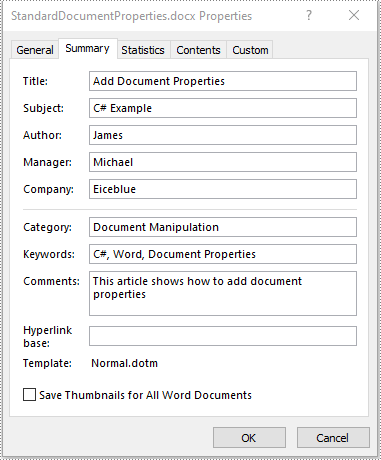
Add Custom Document Properties to a Word Document in C# and VB.NET
A custom document property can be defined by a document author or user. Each custom document property should contain a name, a value and a data type. The data type can be one of these four types: Text, Date, Number and Yes or No. The following steps demonstrate how to add custom document properties with different data types to a Word document:
- Initialize an instance of Document class.
- Load a Word document using Document.LoadFromFile() method.
- Get the custom document properties of the document through Document.CustomDocumentProperties property.
- Add custom document properties with different data types to the document using CustomDocumentProperties.Add(string, object) method.
- Save the result document using Document.SaveToFile() method.
- C#
- VB.NET
using Spire.Doc;
using System;
namespace CustomDocumentProperties
{
class Program
{
static void Main(string[] args)
{
//Create a Document instance
Document document = new Document();
//Load a Word document
document.LoadFromFile("Sample.docx");
//Add custom document properties to the document
CustomDocumentProperties customProperties = document.CustomDocumentProperties;
customProperties.Add("Document ID", 1);
customProperties.Add("Authorized", true);
customProperties.Add("Authorized By", "John Smith");
customProperties.Add("Authorized Date", DateTime.Today);
//Save the result document
document.SaveToFile("CustomDocumentProperties.docx", FileFormat.Docx2013);
}
}
}
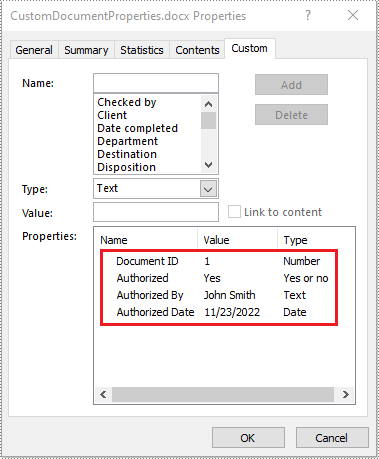
Apply for a Temporary License
If you'd like to remove the evaluation message from the generated documents, or to get rid of the function limitations, please request a 30-day trial license for yourself.
Long papers or research reports are often completed collaboratively by multiple people. To save time, each person can work on their assigned parts in separate documents and then merge these documents into one after finish editing. Apart from manually copying and pasting content from one Word document to another, this article will demonstrate the following two ways to merge Word documents programmatically using Spire.Doc for .NET .
Install Spire.Doc for .NET
To begin with, you need to add the DLL files included in the Spire.Doc for.NET package as references in your .NET project. The DLL files can be either downloaded from this link or installed via NuGet.
PM> Install-Package Spire.Doc
Merge Documents by Inserting the Entire File
The Document.InsertTextFromFile() method provided by Spire.Doc for .NET allows merging Word documents by inserting other documents entirely into a document. Using this method, the contents of the inserted document will start from a new page. The detailed steps are as follows:
- Create a Document instance.
- Load the original Word document using Document.LoadFromFile() method.
- Insert another Word document entirely to the original document using Document.InsertTextFromFile() method.
- Save the result document using Document.SaveToFile() method.
- C#
- VB.NET
using Spire.Doc;
namespace MergeWord
{
class Program
{
static void Main(string[] args)
{
//Create a Document instance
Document document = new Document();
//Load the original Word document
document.LoadFromFile("Doc1.docx", FileFormat.Docx);
//Insert another Word document entirely to the original document
document.InsertTextFromFile("Doc2.docx", FileFormat.Docx);
//Save the result document
document.SaveToFile("MergedWord.docx", FileFormat.Docx);
}
}
}
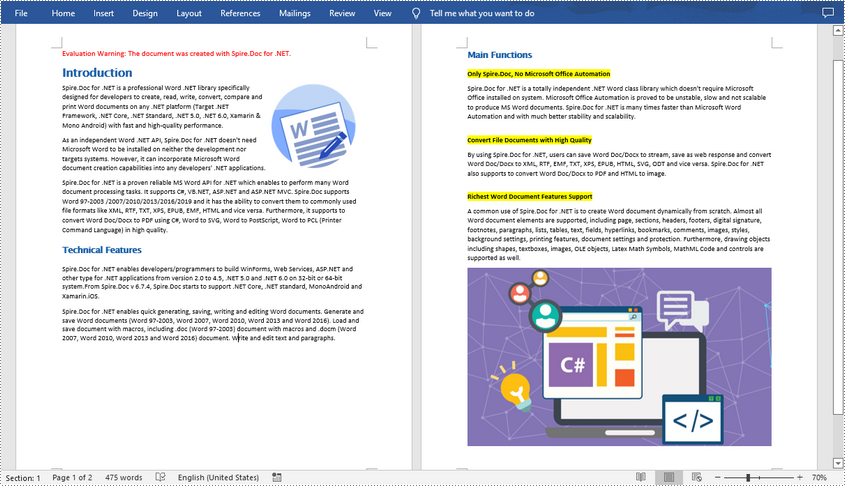
Merge Documents by Cloning Contents
If you want to merge documents without starting a new page, you can clone the contents of other documents to add to the end of the original document. The detailed steps are as follows:
- Load two Word documents.
- Loop through the second document to get all the sections using Document.Sections property, and then loop through all the sections to get their child objects using Section.Body.ChildObjects property.
- Get the last section of the first document using Document.LastSection property, and then add the child objects to the last section of the first document using LastSection.Body.ChildObjects.Add() method.
- Save the result document using Document.SaveToFile() method.
- C#
- VB.NET
using Spire.Doc;
namespace MergeWord
{
class Program
{
static void Main(string[] args)
{
//Load two Word documents
Document doc1 = new Document("Doc1.docx");
Document doc2 = new Document("Doc2.docx");
//Loop through the second document to get all the sections
foreach (Section section in doc2.Sections)
{
//Loop through the sections of the second document to get their child objects
foreach (DocumentObject obj in section.Body.ChildObjects)
{
// Get the last section of the first document
Section lastSection = doc1.LastSection;
//Add all child objects to the last section of the first document
lastSection.Body.ChildObjects.Add(obj.Clone());
}
}
// Save the result document
doc1.SaveToFile("MergeDocuments.docx", FileFormat.Docx);
}
}
}
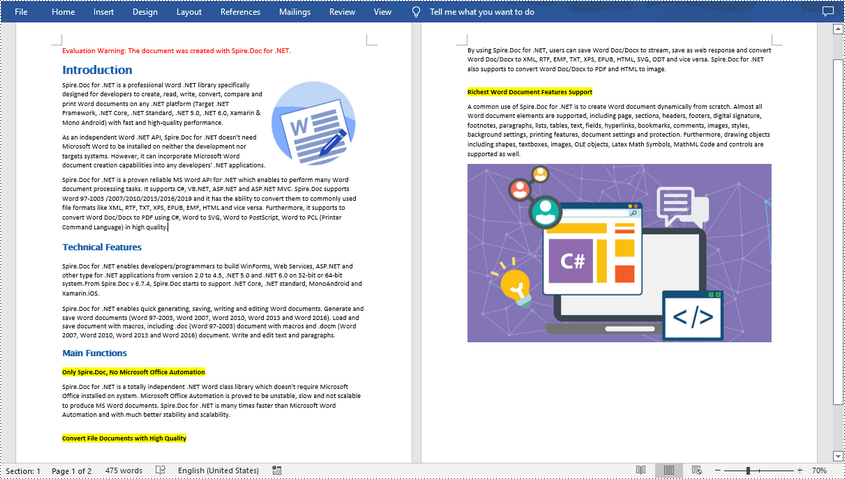
Apply for a Temporary License
If you'd like to remove the evaluation message from the generated documents, or to get rid of the function limitations, please request a 30-day trial license for yourself.
Users can change Word view mode according to own reading habit. This guide introduces a solution to set Word view modes in C# and VB.NET.
There are several Word View Modes provided with customers, including Print Layout, Web Layout, Full Screen, Draft, Outline and Zoom in/out with specified percentage. The view mode can be selected when opening to make the document to be presented to match readers’ reading habit. This guide focuses on demonstrating how to set Word view mode in C# and VB.NET via Spire.Doc for .NET. The screenshot presents the result after setting Word view mode.
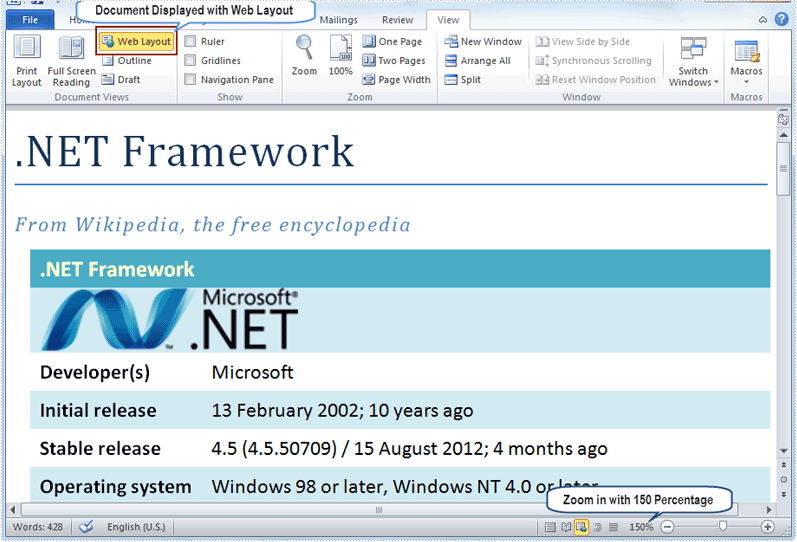
Spire.Doc for .NET, specializing in operating Word in .NET, offers a ViewSetup class to enable users to set Word view modes through assigning specified values for its properties. In this example, the Word view modes will be set as Web Layout with zoom out 150 percent. Therefore, the set properties of ViewSetup class include DocumentViewType, ZoomPercent and ZoomType.
DocumentViewTyp: There are five types provided by Spire.Doc for .NET: None, NormalLayout, OutlineLayout, PrintLayout and WebLayout.
ZoomPercent: The default ZoomPercent is 100. User can set other percent according to requirements. In this example, ZoomPercent is set as 150.
ZoomType: There are four zoom types provided by Spire.Doc for .NET: Full Page to automatically recalculate zoom percentage to fit one full page; None to use the explicit zoom percentage; PageWidth to automatically recalculate zoom percentage to fit page width; TextFit to automatically recalculate zoom percentage to fit text. Because the zoom percentage is set as 150, so the ZoomType is set as None in this example.
Download and install Spire.Doc for .NET and follow the code:
using Spire.Doc;
namespace WordViewMode
{
class Program
{
static void Main(string[] args)
{
Document doc = new Document();
doc.LoadFromFile(@"E:\Work\Documents\WordDocuments\.NET Framework.docx");
doc.ViewSetup.DocumentViewType = DocumentViewType.WebLayout;
doc.ViewSetup.ZoomPercent = 150;
doc.ViewSetup.ZoomType = ZoomType.None;
doc.SaveToFile("WordViewMode.docx", FileFormat.Docx2010);
System.Diagnostics.Process.Start("WordViewMode.docx");
}
}
}
Imports Spire.Doc
Namespace WordViewMode
Friend Class Program
Shared Sub Main(ByVal args() As String)
Dim doc As New Document()
doc.LoadFromFile("E:\Work\Documents\WordDocuments\.NET Framework.docx")
doc.ViewSetup.DocumentViewType = DocumentViewType.WebLayout
doc.ViewSetup.ZoomPercent = 150
doc.ViewSetup.ZoomType = ZoomType.None
doc.SaveToFile("WordViewMode.docx", FileFormat.Docx2010)
System.Diagnostics.Process.Start("WordViewMode.docx")
End Sub
End Class
End Namespace
Spire.Doc, professional Word component, is specially designed for developers to fast generate, write, modify and save Word documents in .NET, Silverlight and WPF with C# and VB.NET. Also, it supports conversion between Word and other popular formats, such as PDF, HTML, Image, Text and so on, in .NET and WPF platform.
Editing a Word document is necessary when you want to improve readability, correct errors, refine formatting, maintain consistency, adapt content, facilitate collaboration, and optimize the document for any other purposes. Programmatically editing a Word document using C# can be a powerful approach to automate document processing and manipulation tasks.
In this article, you will learn how to edit a Word document using C# and the Spire.Doc for .NET library.
- Modify Text in a Word Document
- Change Formatting of Text in a Word Document
- Add New Elements to a Word Document
- Remove Paragraphs from a Word Document
Install Spire.Doc for .NET
To begin with, you need to add the DLL files included in the Spire.Doc for .NET package as references in your .NET project. The DLL files can be either downloaded from this link or installed via NuGet.
PM> Install-Package Spire.Doc
Modify Text in a Word Document in C#
Spire.Doc allows you to programmatically access specific sections and paragraphs in Word documents. To retrieve a particular section, use the Document.Sections[index] property. Then, to get a particular paragraph within that section, leverage the Section.Paragraphs[index] property. Finally, you can update the text content of the paragraph using the Paragraph.Text property.
The steps to modify text in a Word document using C# are as follows:
- Create a Document object.
- Load a Word file from the given file path.
- Get a specific section through Document.Sections[index] property.
- Get a specific paragraph through Section.Paragraphs[index] property.
- Reset the text of the paragraph through Paragraph.Text property.
- Save the updated document to a different Word file.
- C#
using Spire.Doc;
using Spire.Doc.Documents;
namespace ModifyText
{
class Program
{
static void Main(string[] args)
{
// Create a new document object
Document document = new Document();
// Load an existing Word file
document.LoadFromFile("C:\\Users\\Administrator\\Desktop\\input.docx");
// Get a specific section
Section section = document.Sections[0];
// Get a specific paragraph
Paragraph paragraph = section.Paragraphs[0];
// Modify the text of the paragraph
paragraph.Text = "Updated Title";
// Save the document to a different Word file
document.SaveToFile("ModifyText.docx", FileFormat.Docx);
// Dispose resource
document.Dispose();
}
}
}
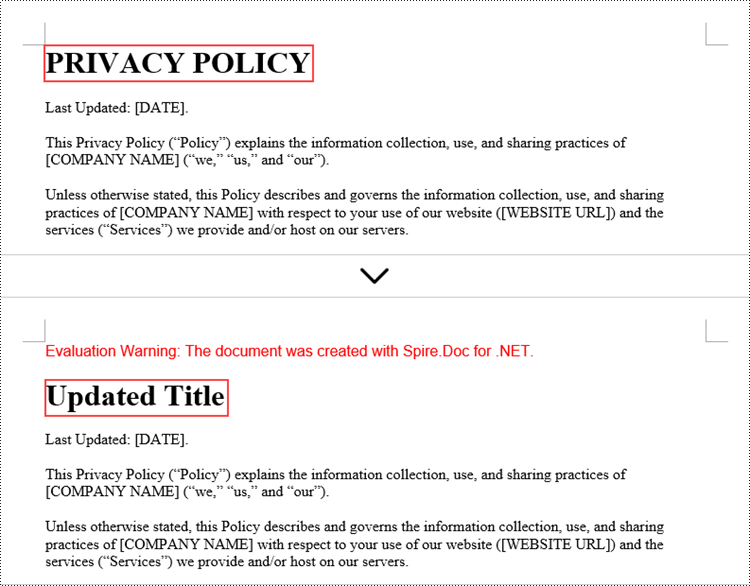
Change Formatting of Text in a Word Document in C#
To change the text formatting within a paragraph, first obtain the paragraph object, then iterate through its child objects to locate the individual text ranges. For each text range, you can reset the formatting using the CharacterFormat property of the TextRange.
The steps to change text formatting in a Word document are as follows:
- Create a Document object.
- Load a Word file from the given file path.
- Get a specific section through Document.Sections[index] property.
- Get a specific paragraph through Section.Paragraphs[index] property.
- Iterate through the child objects in the paragraph.
- Determine if a child object is a text range.
- Get a specific text range.
- Reset the text formatting through TextRange.CharacterFormat property.
- Save the updated document to a different Word file.
- C#
using Spire.Doc;
using Spire.Doc.Documents;
using Spire.Doc.Fields;
using System.Drawing;
namespace ChangeTextFont
{
class Program
{
static void Main(string[] args)
{
// Create a new document object
Document document = new Document();
// Load an existing Word file
document.LoadFromFile("C:\\Users\\Administrator\\Desktop\\input.docx");
// Get a specific section
Section section = document.Sections[0];
// Get a specific paragraph
Paragraph paragraph = section.Paragraphs[2];
// Iterate through the child objects in the paragraph
for (int i = 0; i < paragraph.ChildObjects.Count; i++)
{
// Determine if a child object is text range
if (paragraph.ChildObjects[i] is TextRange)
{
// Get a specific text range
TextRange textRange = (TextRange)paragraph.ChildObjects[i];
// Reset font name for it
textRange.CharacterFormat.FontName = "Corbel Light";
// Reset font size for it
textRange.CharacterFormat.FontSize = 11;
// Reset text color for it
textRange.CharacterFormat.TextColor = Color.Blue;
// Apply italic to the text range
textRange.CharacterFormat.Italic = true;
}
}
// Save the document to a different Word file
document.SaveToFile("ChangeFont.docx", FileFormat.Docx);
// Dispose resource
document.Dispose();
}
}
}
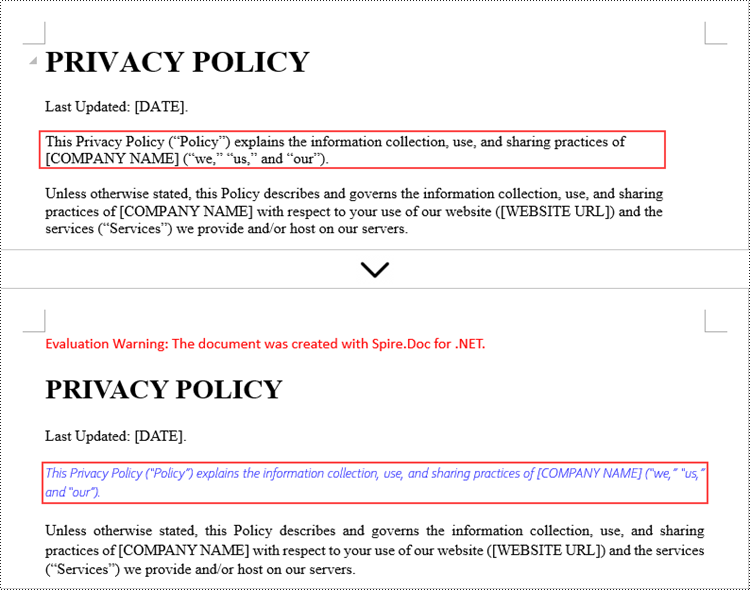
Add New Elements to a Word Document in C#
In addition to modifying the existing content in a Word document, you can also insert various types of new elements, such as text, images, tables, lists, and charts. As most elements are paragraph-based, you have the flexibility to add a new paragraph at the end of the document or insert it mid-document. You can then populate this new paragraph with the desired content, whether that's plain text, images, or other elements.
Below are the steps to add new elements (text and images) to a Word document using C#:
- Create a Document object.
- Load a Word file from the given file path.
- Get a specific section through Document.Sections[index] property.
- Add a paragraph to the section using Section.AddParagraph() method.
- Add text to the paragraph using Paragraph.AppendText() method.
- Add an image to the paragraph using Paragraph.AppendPicture() method.
- Save the updated document to a different Word file.
- C#
using Spire.Doc;
using Spire.Doc.Documents;
namespace AddNewElementsToWord
{
class Program
{
static void Main(string[] args)
{
// Create a new document object
Document document = new Document();
// Load an existing Word file
document.LoadFromFile("C:\\Users\\Administrator\\Desktop\\input.docx");
// Get the last section
Section lastSection = document.LastSection;
// Add a paragraph to the section
Paragraph paragraph = lastSection.AddParagraph();
// Add text to the paragraph
paragraph.AppendText("This text and the image shown below are added programmatically using C# and Spire.Doc for .NET.");
// Add an image to the paragraph
paragraph.AppendPicture("C:\\Users\\Administrator\\Desktop\\logo.png");
// Create a paragraph style
ParagraphStyle style = new ParagraphStyle(document);
style.Name = "FontStyle";
style.CharacterFormat.FontName = "Times New Roman";
style.CharacterFormat.FontSize = 12;
document.Styles.Add(style);
// Apply the style to the paragraph
paragraph.ApplyStyle(style.Name);
// Save the document to a different Word file
document.SaveToFile("AddNewElements.docx", FileFormat.Docx);
// Dispose resource
document.Dispose();
}
}
}
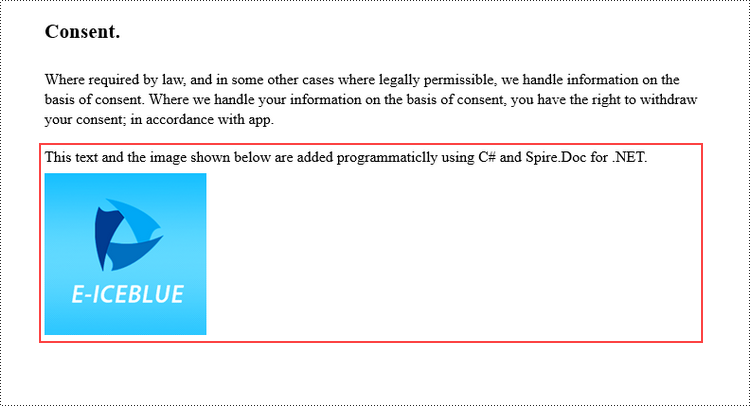
Remove Paragraphs from a Word Document in C#
With the Spire.Doc library, you can perform a variety of document operations, including updating existing content, adding new elements, as well as removing elements from a Word document. For example, to remove a paragraph from the document, you can use the Section.Paragraphs.RemoveAt() method.
The following are the steps to remove paragraphs from a Word document using C#:
- Create a Document object.
- Load a Word file from the given file path.
- Get a specific section through Document.Sections[index] property.
- Remove a specific paragraph from the section using Section.Paragraphs.RemoveAt() method.
- Save the updated document to a different Word file.
- C#
using Spire.Doc;
namespace RemoveParagraphs
{
class Program
{
static void Main(string[] args)
{
// Create a new document object
Document document = new Document();
// Load an existing Word file
document.LoadFromFile("C:\\Users\\Administrator\\Desktop\\input.docx");
// Get a specific section
Section section = document.Sections[0];
// Remove a specific paragraph
section.Paragraphs.RemoveAt(0);
// Save the document to a different Word file
document.SaveToFile("RemoveParagraph.docx", FileFormat.Docx);
// Dispose resource
document.Dispose();
}
}
}
Apply for a Temporary License
If you'd like to remove the evaluation message from the generated documents, or to get rid of the function limitations, please request a 30-day trial license for yourself.
